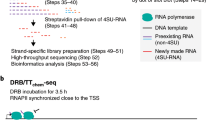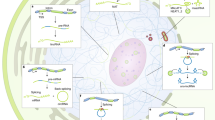Abstract
RNA polymerase (Pol) III is highly specialized for the production of short non-coding RNAs. Once considered to be under relatively simple controls, recent studies using chromatin immunoprecipitation followed by sequencing (ChIP–seq) have revealed unexpected levels of complexity for Pol III regulation, including substantial cell-type selectivity and intriguing overlap with Pol II transcription. Here I describe these novel insights and consider their implications and the questions that remain.
This is a preview of subscription content, access via your institution
Access options
Subscribe to this journal
Receive 12 print issues and online access
$189.00 per year
only $15.75 per issue
Buy this article
- Purchase on Springer Link
- Instant access to full article PDF
Prices may be subject to local taxes which are calculated during checkout



Similar content being viewed by others
References
Roeder, R. G. & Rutter, W. J. Multiple forms of DNA-dependent RNA polymerase in eukaryotic organisms. Nature 224, 234–237 (1969).
Marshall, L. & White, R. J. Non-coding RNA production by RNA polymerase III is implicated in cancer. Nature Rev. Cancer 8, 911–914 (2008).
Marshall, L., Kenneth, N. S. & White, R. J. Elevated tRNAiMet synthesis can drive cell proliferation and oncogenic transformation. Cell 133, 78–89 (2008).
Kedinger, C., Gniazdowski, M., Mandel, J. L., Gissinger, F. & Chambon, P. α-Amanitin: a specific inhibitor of one of two DNA-dependent RNA polymerase activities from calf thymus. Biochem. Biophys. Res. Commun. 38, 165–171 (1970).
Harismendy, O. et al. Genome-wide location of yeast RNA polymerase III transcription machinery. EMBO J. 22, 4738–4747 (2003).
Roberts, D. N., Stewart, A. J., Huff, J. T. & Cairns, B. R. The RNA polymerase III transcriptome revealed by genome-wide localization and activity-occupancy relationships. Proc. Natl Acad. Sci. USA 100, 14695–14700 (2003).
Moqtaderi, Z. & Struhl, K. Genome-wide occupancy profile of the RNA polymerase III machinery in Saccharomyces cerevisiae reveals loci with incomplete transcription complexes. Mol. Cell. Biol. 24, 4118–4127 (2004).
Barski, A. et al. Pol II and its associated epigenetic marks are present at Pol III-transcribed noncoding RNA genes. Nature Struct. Mol. Biol. 17, 629–634 (2010).
Canella, D., Praz, V., Reina, J. H., Cousin, P. & Hernandez, N. Defining the RNA polymerase III transcriptome: genome-wide localization of the RNA polymerase III transcription machinery in human cells. Genome Res. 20, 710–721 (2010).
Moqtaderi, Z. et al. Genomic binding profiles of functionally distinct RNA polymerase III transcription complexes in human cells. Nature Struct. Mol. Biol. 17, 635–640 (2010).
Oler, A. J. et al. Human RNA polymerase III transcriptomes and relationships to Pol II promoter chromatin and enhancer-binding factors. Nature Struct. Mol. Biol. 17, 620–628 (2010).
Raha, D. et al. Close association of RNA polymerase II and many transcription factors with Pol III genes. Proc. Natl Acad. Sci. USA 107, 3639–3644 (2010).
Batzer, M. A. & Deininger, P. L. Alu repeats and human genomic diversity. Nature Rev. Genet. 3, 370–379 (2002).
Noma, K., Cam, H. P., Maraia, R. & Grewal, S. I. A role for TFIIIC transcription factor complex in genome organization. Cell 125, 859–872 (2006).
Borchert, G. M., Lanier, W. & Davidson, B. L. RNA polymerase III transcribes human microRNAs. Nature Struct. Mol. Biol. 13, 1097–1101 (2006).
Ozsolak, F. et al. Chromatin structure analyses identify miRNA promoters. Genes Dev. 22, 3172–3183 (2008).
Bortolin-Cavaille, M., Dance, M., Weber, M. & Cavaille, J. C19MC microRNAs are processed from introns of large Pol-II, non-protein-coding transcripts. Nucleic Acids Res. 37, 3464–3473 (2009).
Schramm, L. & Hernandez, N. Recruitment of RNA polymerase III to its target promoters. Genes Dev. 16, 2593–2620 (2002).
Schramm, L., Pendergrast, P. S., Sun, Y. & Hernandez, N. Different human TFIIIB activities direct RNA polymerase III transcription from TATA-containing and TATA-less promoters. Genes Dev. 14, 2650–2663 (2000).
Dittmar, K. A., Goodenbour, J. M. & Pan, T. Tissue-specific differences in human transfer RNA expression. PLoS Genet. 2, 2107–2115 (2006).
White, R. J. RNA polymerases I and III, growth control and cancer. Nature Rev. Mol. Cell Biol. 6, 69–78 (2005).
Ciesla, M. & Boguta, M. Regulation of RNA polymerase III transcription by Maf1 protein. Acta Biochim. Pol. 55, 215–225 (2008).
Sutcliffe, J. E., Brown, T. R. P., Allison, S. J., Scott, P. H. & White, R. J. Retinoblastoma protein disrupts interactions required for RNA polymerase III transcription. Mol. Cell. Biol. 20, 9192–9202 (2000).
Crighton, D. et al. p53 represses RNA polymerase III transcription by targeting TBP and inhibiting promoter occupancy by TFIIIB. EMBO J. 22, 2810–2820 (2003).
Desai, N. et al. Two steps in Maf1-dependent repression of transcription by RNA polymerase III. J. Biol. Chem. 280, 6455–6462 (2005).
Kenneth, N. S. et al. TRRAP and GCN5 are used by c-Myc to activate RNA polymerase III transcription. Proc. Natl Acad. Sci. USA 104, 14917–14922 (2007).
Gomez-Roman, N., Grandori, C., Eisenman, R. N. & White, R. J. Direct activation of RNA polymerase III transcription by c-Myc. Nature 421, 290–294 (2003).
Owen, T. J. et al. Epstein-Barr virus-encoded EBNA1 enhances RNA polymerase III-dependent EBER expression through induction of EBER-associated cellular transcription factors. Mol. Cancer 9, 241 (2010).
Kenneth, N. S. & White, R. J. Regulation by c-Myc of ncRNA expression. Curr. Opin. Genet. Dev. 19, 38–43 (2009).
Steiger, D., Furrer, M., Schwinkendorf, D. & Gallant, P. Max-independent functions of Myc in Drosophila melanogaster. Nature Genet. 40, 1084–1091 (2008).
Johnson, S. A. S., Dubeau, L. & Johnson, D. L. Enhanced RNA polymerase III-dependent transcription is required for oncogenic transformation. J. Biol. Chem. 283, 19184–19191 (2008).
Listerman, I., Bledau, A. S., Grishina, I. & Neugebauer, K. M. Extragenic accumulation of RNA polymerase II enhances transcription by RNA polymerase III. PLoS Genet. 3, e212 (2007).
Haldar, D. & Kamakaka, R. T. tRNA genes as chromatin barriers. Nature Struct. Mol. Biol. 13, 192–193 (2006).
Mertens, C. & Roeder, R. G. Different functional modes of p300 in activation of RNA polymerase III transcription from chromatin templates. Mol. Cell. Biol. 28, 5764–5776 (2008).
Boyer, L. A., Latek, R. R. & Peterson, C. L. The SANT domain: a unique histone-tail-binding module? Nature Rev. Mol. Cell Biol. 5, 158–163 (2004).
Donze, D. & Kamakaka, R. T. RNA polymerase III and RNA polymerase II promoter complexes are heterochromatin barriers in Saccharomyces cerevisiae. EMBO J. 20, 281–287 (2001).
Oki, M. & Kamakaka, R. T. Barrier function at HMR. Mol. Cell 19, 707–716 (2005).
Scott, K. C., Merrett, S. L. & Willard, H. F. A heterochromatin barrier partitions the fission yeast centromere into discrete chromatin domains. Curr. Biol. 16, 119–129 (2006).
Lunyak, V. V. et al. Developmentally regulated activation of a SINE B2 repeat as a domain boundary in organogenesis. Science 317, 248–251 (2007).
Roman, A. C. et al. Dioxin receptor and slug transcription factors regulate the insulator activity of B1 SINE retrotransposons via an RNA polymerase switch. Genome Res. 21, 422–432 (2011).
Acknowledgements
The author gratefully acknowledges funding from Cancer Research UK.
Author information
Authors and Affiliations
Corresponding author
Ethics declarations
Competing interests
The author declares no competing financial interests.
Related links
Glossary
- 5S rRNA
-
(5S ribosomal RNA). The smallest of the rRNAs. It is found in the large subunit of ribosomes.
- 7SK RNA
-
Binds and represses P-TEFb, a factor that stimulates transcript elongation by RNA polymerase II.
- 7SL RNA
-
Acts as a scaffold within the signal recognition particle (SRP), which inserts nascent polypeptides into membranes.
- H1 RNA
-
The RNA component of RNase P, which processes the 5′ end of tRNAs.
- hY RNA
-
Human Y RNA, which has putative roles in DNA replication and quality control of non-coding RNAs.
- MRP RNA
-
Mitochondrial RNA processing (MRP) RNA is part of a ribonucleoprotein particle that processes precursor ribosomal RNA and mitochondrial DNA replication primers. MRP RNA (encoded by the RMRP gene) also associates with the catalytic subunit of human telomerase reverse transcriptase (TERT) to form an RNA-dependent RNA polymerase which generates RNAs that are processed by DICER into small interfering RNAs.
- SANT domain
-
A motif of ~50 amino acid residues that is found in transcription cofactors, chromatin-remodelling proteins and BDP1.
- U6 snRNA
-
(U6 small nuclear RNA). A component of splicesomes, which are required for splicing precursor mRNAs.
- Vault RNA
-
Part of a very large ribonucleoprotein particle that is implicated in multidrug resistance and intracellular transport. Although 20% of vault RNA is found in vault particles, ~80% is free in the cytosol, where it is processed by DICER to generate small intefering RNAs that downregulate CYP3A4, a key enzyme in drug metabolism.
Rights and permissions
About this article
Cite this article
White, R. Transcription by RNA polymerase III: more complex than we thought. Nat Rev Genet 12, 459–463 (2011). https://doi.org/10.1038/nrg3001
Published:
Issue Date:
DOI: https://doi.org/10.1038/nrg3001
This article is cited by
-
MALAT1/ mir-1-3p mediated BRF2 expression promotes HCC progression via inhibiting the LKB1/AMPK signaling pathway
Cancer Cell International (2023)
-
tRNA-Cys gene clusters exhibit high variability in Arabidopsis thaliana
BMC Plant Biology (2023)
-
The tRNA regulome in neurodevelopmental and neuropsychiatric disease
Molecular Psychiatry (2022)
-
Development of a CRISPR/Cpf1 system for targeted gene disruption in Aspergillus aculeatus TBRC 277
BMC Biotechnology (2021)
-
Landscape of transcription termination in Arabidopsis revealed by single-molecule nascent RNA sequencing
Genome Biology (2021)



